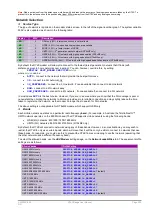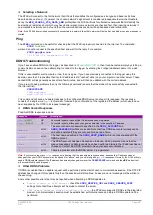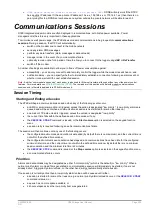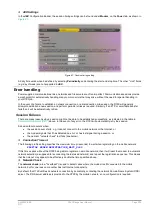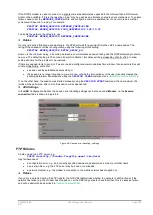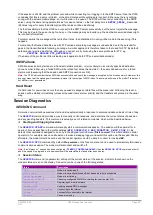
UM-0085-B09
DT80 Range User Manual
Page 213
RG
Figure 84: Email configuration page
In the above screen shot, the logger has been set up to use the (fictitious) third party email provider
yourdomain.com
.
The server name, as specified by the provider, is
smtp.yourdomain.com
. The account name (
user
) and password have
also been entered.
Email sent by this logger will appear to come from "
Cold Room 3
", with email address of
user@yourdomain.com
. For
third party email providers, it is normally a requirement that the "from" email address is set to the email address
associated with the account.
Dynamic DNS
, if you wish to remotely connect to the
DT80
's servers – for example the web
server, in order to run
dEX
– then it is necessary that a) the IP address allocated to the
DT80
by the mobile network is a
public address, and b) the required TCP ports (e.g. port 80 for the web server) are not blocked by the mobile carrier.
Assuming these requirements are satisfied, there is now a third requirement – you need to know what the
DT80
's IP
address is, so you can type it into your web browser (or FTP client, or
DeTransfer
). If the logger is on the desk next to
you then you can read the IP address from the modem status screen on the LCD. This is, however, somewhat
inconvenient if the logger is remote, which is where Dynamic DNS comes in.
The
Dynamic Domain Name System
(DDNS) is an Internet service provided by various companies where a fixed
domain name (e.g. "
mylogger.dyndns.org
") can be mapped onto the logger's current dynamic IP address.
This service works as follows:
You create an account with a DDNS service provider, e.g.
dyndns.com
or
no-ip.com
. Both free and paid subscription
types are normally available.
•
You create a domain name (e.g.
site42.megatech.no-ip.org
) for the logger, and attach it to your DDNS
account. With a free account, you can typically create up to 5 domain names for the account, which would allow
you to access 5 different loggers.
•
You enable DDNS on the
DT80
by entering the details of your account and your chosen domain name into the
appropriate profile settings, as detailed below.
•
Next time the
DT80
connects to the mobile network, it will automatically contact the DDNS server and advise it
of the IP address that it has just been given by the network.
•
You enter the logger's domain name into your web browser, which does a normal Domain Name System (DNS)
query to determine the IP address. This query is routed to the DDNS server, which will return the last IP
address it received from the
DT80
. Assuming that the
DT80
is currently connected to the network, you will now
be able to communicate with it.
Configuring DDNS
Note:
Remember that DDNS will only work if your mobile carrier provides a public IP address.
To set up DDNS on the
DT80
, the following profile settings need to be set. First, the protocol needs to be enabled:
PROFILE MODEM_SESSION DDNS_ENABLE=YES
Second, the details of the DDNS provider need to be checked and updated if necessary. The
DT80
has been tested with
two DDNS providers –
dyndns.com
and
no-ip.com
. The
DT80
's default settings are
PROFILE MODEM_SESSION DDNS_SERVER_URI=members.dyndns.org/nic/update
PROFILE MODEM_SESSION DDNS_SERVER_PORT=80
which are correct for the
dyndns.com
service.






















